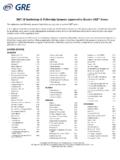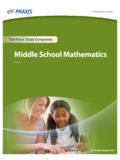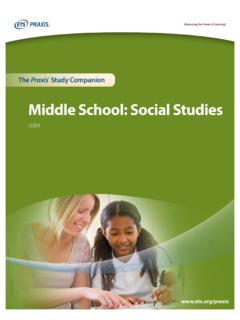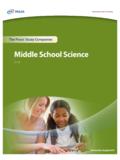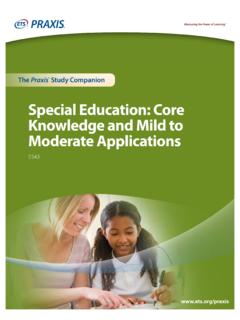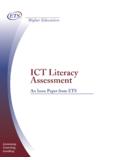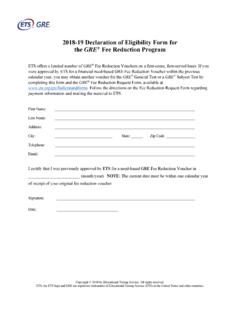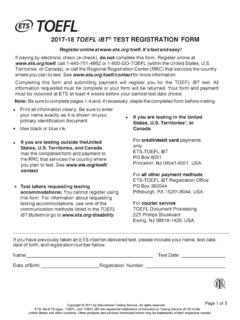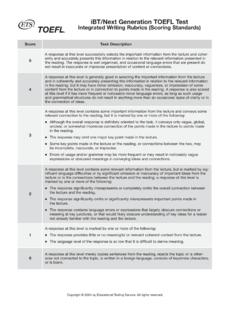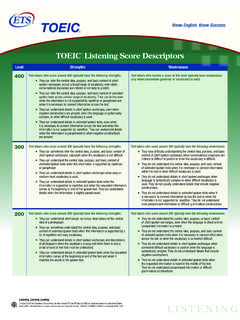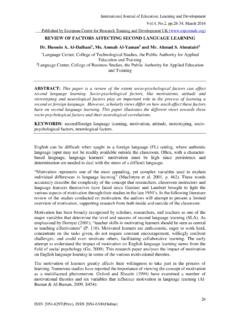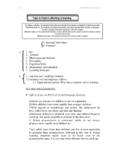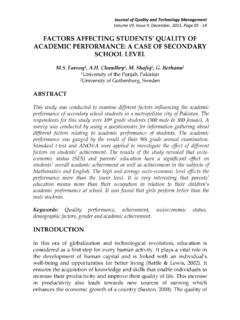Transcription of Guidelines for Best Test Development Practices to Ensure ...
1 Guidelines for Best Test Development Practices to Ensure Validity and Fairness for international english language proficiency AssessmentsJohn W. Young, Youngsoon So & Gary J. Ockey Educational Testing ServiceCopyright 2013 by Educational Testing Service. All rights reserved. ETS, the ETS logo and LISTENING. LEARNING. LEADING. are registered trademarks of Educational Testing Service (ETS). All other trademarks are property of their respective owners. 224591 Guidelines for Best Test Development Practices to Ensure Validity and Fairness for international english language proficiency AssessmentsJohn W. Young, Youngsoon So, & Gary J. OckeyEducational Testing Service Guidelines for Best Test Development Practices to Ensure Validity and Fairness for international english language proficiency Assessments2 Table of ContentsIntroduction ..3 Definitions of Key Terms ..4 Planning and Developing an assessment ..6 Using Selected-Response Questions ..7 Scoring Constructed-Response Test Items.
2 9 Statistical Analyses of Test Results ..13 Validity Research ..16 Providing Guidance to Stakeholders ..17 Giving a Voice to Stakeholders in the Testing Process ..19 Summary ..19 Bibliography ..203 IntroductionEducational Testing Service (ETS) is committed to ensuring that our assessments and other products are of the highest technical quality and as free from bias as possible. To meet this commitment, all ETS assessments and products undergo rigorous formal reviews to Ensure that they adhere to the ETS fairness Guidelines , which are set forth in a series of six publications to date (ETS, 2002, 2003, 2005, 2007, 2009a, 2009b). These publications document the standards and best Practices for quality and fairness that ETS strives to adhere to in the Development of all of our assessments and publication, Guidelines for Best Test Development Practices to Ensure Validity and Fairness for international english language proficiency Assessments, adds to the ETS series on fairness, and focuses on the recommended best Practices for the Development of english language proficiency assessments taken by international test-taker populations.
3 Assessing english learners requires attention to certain challenges not encountered in most other assessment contexts. For instance, the language of the assessment items and instructions english is also the ability that the test aims to measure. The diversity of the global english learner population in terms of language learning backgrounds, purposes and motivations for learning, and cultural background, among other factors, represents an additional challenge to test developers. This publication recognizes these and other issues related to assessing international english learners and proposes Guidelines for test Development to Ensure validity and fairness in the assessment process. Guidelines for Best Test Development Practices to Ensure Validity and Fairness for international english language proficiency Assessments highlights issues relevant to the assessment of english in an international setting. This publication complements two existing ETS publications, ETS international Principles for Fairness Review of Assessments (ETS, 2007), which focuses primarily on general fairness concerns and the importance of considering local religious, cultural, and political values in the Development of assessments used with international test-takers, and Guidelines for the assessment of english language Learners (ETS, 2009b), which spotlights assessments for K 12 english learners in the United States.
4 The ETS international Principles for Fairness Review of Assessments (ETS, 2009a) focuses on general principles of fairness in an international context and how these can be balanced with assessment principles. Readers interested in assessing english learners in international settings may find all three of these complementary publications to be valuable sources of developing these Guidelines , the authors reviewed a number of existing professional standards documents in educational assessment and language testing, including the AERA/APA/NCME Standards for Educational and Psychological Testing (American Educational Research Association, American Psychological Association, & National Council on Measurement in Education, 1999); the international Test Commission s international Guidelines for Test Use (ITC, 2000); the European Association for language Testing and assessment s Guidelines for Good Practice in language Testing and assessment (EALTA, 2006); the Association of language Testers in Europe s the ALTE Code of Practice (ALTE, 2001); the Japan language Testing Association s Code of Good Testing Practice (JLTA, ).
5 And the international language Testing Association s Guidelines for Practice (ILTA, 2007). In addition, the authors consulted with internal and external experts in language assessment while developing the Guidelines contained in this publication. This publication is intended to be widely distributed and accessible to all stakeholders and interested parties. It can be found on the ETS website: for Best Test Development Practices to Ensure Validity and Fairness for international english language proficiency Assessments4 The use of an assessment affects different groups of stakeholders in different ways. For issues of validity and fairness, it is likely that different groups of stakeholders have different concerns, and consequently different expectations. This publication is primarily intended to serve the needs of educational agencies and organizations involved in the Development , administration, and scoring of international english language proficiency assessments.
6 Others, such as individuals and groups using international english language proficiency assessments for admissions and selection, or for diagnostic feedback in instructional programs, and international english teachers and students may also find the publication Guidelines are organized as follows: We begin with definitions of key terms related to assessment validity and fairness. We then discuss critical stages in the planning and Development of an assessment of english proficiency for individuals who have learned english in a foreign- language context. Next, we address more technical concerns in the assessment of english proficiency , including issues related to the Development and scoring of selected- and constructed-response test items, analyzing score results, and conducting validity research. This discussion is followed by a section which provides guidance for assuring that stakeholder groups are informed of an assessment practice and are given opportunities to provide feedback into the test Development of Key TermsThe following key terms are used throughout this publication: Bias in assessment refers to the presence of systematic differences in the meaning of test scores associated with group membership.
7 Tests which are biased are not fair to one or more groups of test-takers. For instance, a reading assessment which uses a passage about a cultural event in a certain part of the world may be biased in favor of test-takers from that country or region. An example would be a passage about Halloween, which might favor test-takers from western countries which celebrate the holiday and disadvantage test-takers from areas where Halloween is not celebrated or not well known. A construct is an ability or skill that an assessment aims to measure. Examples of common assessment constructs include academic english language proficiency , mathematics knowledge, and writing ability. The construct definition of an assessment becomes the basis for the score interpretations and inferences that will be made by stakeholders. A number of considerations ( , age of the target population, context of target- language use, the specific language register that is relevant to the assessment purpose, the decisions that assessment scores are intended to inform) should collectively be taken into account in defining a construct for a particular assessment .
8 For example, a construct for an english listening test might be phrased as follows: The test measures the degree to which students have the english listening skills required for english -medium middle-school contexts. Construct-irrelevant variance is an effect on differences in test scores that is not attributable to the construct that the test is designed to measure. An example of construct-irrelevant variance would be a speaking test that requires a test-taker to read a graph and then describe what the graph shows. If reading the graph requires background knowledge or cognitive abilities that are not 5available to all individuals in the target population, score differences observed among test-takers could be due to differences in their ability to read a complex graph in addition to differences in their speaking proficiency the target construct. The graph-reading ability is irrelevant to measuring the target construct and would be the cause of construct-irrelevant variance.
9 When construct irrelevant variance is present, it can reduce the validity of score interpretations. Reliability refers to the extent to which an assessment yields the same results on different occasions. Ideally, if an assessment is given to two groups of test-takers with equal ability under the same testing conditions, the results of the two assessments should be the same, or very similar. Different types of reliability are of interest depending on which specific source of inconsistency is believed to threaten score reliability. For example, inter-rater reliability demonstrates the degree of agreement among raters. Inter-rater reliability is typically reported when subjectivity is involved in scoring test-taker responses, such as in scoring constructed-response items. Internal consistency is another type of reliability that is commonly reported in many large-scale assessments. It refers to the degree to which a set of items measures a single construct, as they were originally designed to.
10 Cronbach s alpha is the most commonly used indicator of internal consistency. Constructed-response and selected-response items are two broad categories of test items. The distinction between the two categories refers to the type of response expected from the test-takers. A response is the answer that a test-taker gives to a test question. A constructed-response item requires a test-taker to produce a spoken or written response rather than selecting an answer choice that has been provided. An example would be to write a short essay on a given topic. A selected-response item provides answer choices from which the test-taker must choose the correct answer(s). True-false items, multiple-choice questions, and matching items are examples of selected-response items. Multiple-choice questions, the most frequently used item type, consist of two parts: (i) a stem that provides a question to be answered and (ii) response options that contain one correct answer and several incorrect options.
